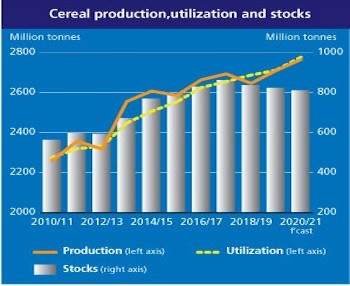Early outlook for 2021 crops

Although early in the season, FAO expects global cereal production to increase for a third consecutive year in 2021. Harvesting of the winter wheat crop has already begun in some countries in the northern hemisphere and current crop conditions point to slightly better prospects compared to earlier expectations, lifting the preliminary 2021 global wheat production forecast to 785 million tonnes. In the European Union (EU), production is forecast to rise sharply to 137 million tonnes in 2021 based on an upturn in wheat acreage and favourable winter crop conditions at the start of spring supporting yield expectations above both the previous year’s low level and the five-year average. Similarly, in the United Kingdom, wheat crops are in good conditions having benefited from drier and warmer weather in late February and March following an excessively wet winter, and production is forecast to reach 14 million tonnes. In the Russian Federation, despite improved rainfall that partly alleviated early-season moisture deficits, a cold spell in February is likely to result in higher-than-normal rates of winterkill in the wheat-producing Southern district due to a lack of sufficient snow cover. As a result, and combined with a decline in plantings, production is foreseen to decrease to 79 million tonnes in 2021. In Ukraine, prospects are favourable and official data indicate that wheat production would increase to an above-average level of 27.5 million tonnes. In the United States of America (USA), official data indicate a moderately larger area sown to winter wheat compared to initial estimates. This increase is foreseen to more than offset a reduction in spring sowings and, consequently, total wheat plantings are estimated to be 5 percent higher year-on-year but still the fourth smallest area on record. Based predominantly on the acreage expansion, as less-than-ideal weather has contained yield prospects, wheat production is forecast to increase marginally to about 52 million tonnes in 2021. In Asia, wheat production in Pakistan is foreseen to reach at least the official target of 27 million tonnes, underpinned by an above‑average planted area. The outlook in India is also favourable and wheat production is officially forecast at a record of 109 million tonnes. Based on recent field assessments reporting average conditions and good soil moisture levels throughout the country, 2021 production in China is pegged at 135.5 million tonnes, almost unchanged on a yearly basis. In the Near East, abnormal dryness continues to undermine the production outlook in several countries.
Harvesting of the 2021 coarse grain crops has started in southern hemisphere countries and prospects continue to point to above-average outputs. In South America, maize production in Argentina is on track to reach an above-average level of 58 million tonnes in 2021, mostly on account of a near-record sown area. In Brazil, the aggregate maize output is forecast at a record 108 million tonnes, resting on expectations of an expanded planted area for the 2021 main season crop, driven by favourable price prospects. In Southern Africa, with continued conducive weather conditions in South Africa, the leading maize-producing country in the region, yields could reach multi-year highs and, combined with an increase in the area sown, push up production to a near-record level of 17 million tonnes in 2021. In the northern hemisphere, planting of the 2021 maize crop has recently begun. In the largest global producer, the USA, early estimates from the March Prospective Plantings report indicate that the maize acreage will likely expand by 1 percent this year, an increase that falls short of market expectations given the strong demand and price prospects.
Cereal markets in 2020/21
FAO’s forecast for world cereal production in 2020 has been scaled up marginally this month and now stands at 2 765 million tonnes, 2 percent above the previous year’s outturn. The latest increase mostly reflects upward revisions to maize production estimates in India, with official data indicating higher than previously expected yields, and to a lesser extent in the Russian Federation. The estimate for world rice production has also been raised slightly, primarily reflecting less downcast expectations for the offseason crop in Thailand, combined with small upward adjustments to production in various other countries.
The forecast for global cereal utilization in 2020/21 has been raised by 11.0 million tonnes from the previous report and now stands at 2 777 million tonnes, 2.4 percent above the 2019/20 level. The bulk of this month’s revision stems from an 8.4 million tonne increase in the forecast of world wheat utilization in 2020/21 to 763 million tonnes, 1.7 percent above the 2019/20 level. The monthly increase reflects higher estimates of feed use of wheat in China amidst strong demand, as its livestock sector recovers from African swine fever (ASF), and highly elevated domestic maize prices. Also owing mostly to an upwards revision to feed use of barley in China, the 2020/21 global coarse grains utilization forecast has been raised by 2.9 million tonnes this month to 1 500 million tonnes, up 2.9 percent from 2019/20. Global rice utilization in 2020/21 is seen to reach an all-time high of 514 million tonnes, little changed from March expectations and 1.9 percent above the previous season’s estimate.
Click here to see more...